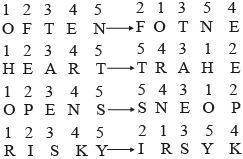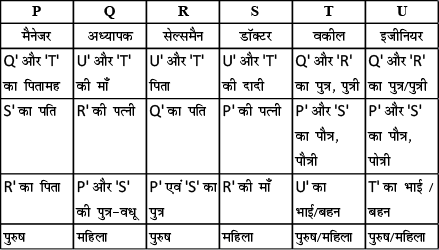सादृश्यता परीक्षा (Analogy Test) शार्ट ट्रिक और उदहारण
सादृश्यता का अर्थ समानता होता है। इसका उद्देश्य वस्तुओं के बीच समानता या उनमें अन्तर्निहित आन्तरिक संबंधों को समझने एवं विश्लेषण करने की योग्यता को परखना है। समान संबंधों के आधार पर समानता का परीक्षण सादृश्यता का मुख्य उद्देश्य है।
इससे संबंधित प्रश्न विभिन्न तत्वों, वस्तुओं, घटनाओं, क्रियाओं इत्यादि के अंतर्संबंधों को समझने और परखने की योग्यता की जांच के लिए होते हैं। यद्यपि ऐसे प्रश्न आसान प्रतीत होते हैं, किन्तु थोड़ी भी असावधानी पर गलत होने की सम्भावना बनी रहती है।
अतः ऐसे प्रश्नों का उत्तर देते समय पूरी सावधानी बरतनी चाहिए। शब्दों को व्यापक अर्थों में समझने का प्रयास करना चाहिए। इस परीक्षण के अन्तर्गत प्रश्न अंक, अक्षर तथा शब्द तीनों पर आधारित होते हैं। अक्षरों पर आधारित प्रश्नों को हल करने के लिए अंग्रेज़ी वर्णमाला में विभिन्न अक्षरों की स्थिति याद रखनी चाहिए।
सादृश्यता पर प्रश्न प्रत्येक प्रकार के संबंधों पर भी आधारित होते हैं जो हम सोचते हैं या जिसे हम अपने दैनिक जीवन में पाते हैं। कुछ उदाहरणों के द्वारा इस प्रकार के प्रश्नों पर गौर करें:
पूछे जाने वाले प्रश्नों पर एक दृष्टि
1. शब्द समरूपता
उदाहरण 1. जिस प्रकार ‘इंतजार’ का संबंध ‘उबन’ से है, उसी प्रकार ‘शिक्षा’ का संबंध किससे है?
- पुस्तक से
- स्कूल से
- पाठ्यक्रम से
- ज्ञान-वर्धन से
हल (4): जिस प्रकार ‘इंतजार’ करने पर ‘उबन’ होती है, उसी प्रकार ‘शिक्षा’ ग्रहण करने पर ‘ज्ञान-वर्धन’ होता है।
अतः, ? ⇒ ज्ञान-वर्धन
उदाहरण 2. दिये गए विकल्पों में से कौन प्रश्नवाचक स्थान पर आएगा?
बिम्बलडन-ट्राॅफी : टेनिस :: वाकर कप : ?
- गोल्फ
- कुश्ती
- बाॅक्सिंग
- घुड़दौड़
हल (1): ‘बिम्बलडन ट्राॅफी’, टेनिस की एक प्रतियोगिता है, उसी प्रकार ‘वाकर कप’, गोल्फ की एक प्रतियोगिता है।
अतः, ? ⇒ गोल्फ
2. अक्षर समरूपता
उदाहरण 3. दिये गए विकल्पों में से कौन प्रश्नवाचक स्थान पर आएगा?
JPLM : NTPQ :: BKLO : ?
- DOPS
- FOPS
- FOQR
- FRPS
हल (2):

3. संख्या समरूपता
उदाहरण 4. दिये गए विकल्पों में से कौन प्रश्नवाचक स्थान पर आएगा?
25 : 630 :: 10 : ?
- 105
- 47
- 18
- 27
हल (1): (25 × 25) + 5 = 630
(10 × 10) + 5 = 105.
4. अक्षर-संख्या समरूपता
उदाहरण 5. ‘8’ का ’16P’ से और ‘6’ का ’12L’ से जो संबंध है वही संबंध ’11’ का …………….. से है।
- 22 R
- 22 K
- 22 J
- इनमें से कोई नहीं
हल (4): 8 × 2 = 16 एवं
(अंग्रेज़ी वर्णमाला में P का स्थान 16वां है।)
6 × 2 = 12 एवं L
(अंग्रेजी वर्णमाला में L का स्थान 12वां है।)
अतः 11 × 2 = 22 एवं V
(अंग्रेज़ी वर्णमाला में V का स्थान 22 वां है।)
साधित उदाहरण (Solved Examples)
1. जिस प्रकार ‘b’ का संबंध ‘doubt’ से है, उसी प्रकार ‘h’ का संबंध किससे है?
- house
- honest
- hope
- inhibit
हल (2): जिस प्रकार अक्षर ‘b’ का उच्चारण ‘doubt’ शब्द में नहीं किया जाता है।, उसी प्रकार अक्षर ‘h’ का उच्चारण शब्द honest में नहीं किया जाता है।
अतः ? ⇒ honest
2. जिस प्रकार ‘प्रवेश’ का संबंध ‘निर्गम’ से है, उसी प्रकार ‘निष्ठा’ का संबंध किससे है?
- झूठ
- विश्वासघात
- बेईमानी
- सत्य
हल (2): जिस प्रकार ‘प्रवेश’ का विपरीत ‘निर्गम’ होता है, उसी प्रकार ‘निष्ठा’ का विपरीत ‘विश्वासघात’ होता है।
अतः, ? ⇒ विश्वासघात
3. निम्नलिखित में किस जोडे का संबंध ‘OFTEN : FOTNE’ के समान है?
- HEART : TRAHE
- OPENS : SNEOP
- RISKY : IRSYK
- FIRST : IFRST
हल (c):

4. दिये गए विकल्पों में से कौन प्रश्नवाचक स्थान पर आएगा?
टका : बांग्लादेश :: लीरा : ?
- कंबोडिगा
- इटली
- भारत
- पाकिस्तान
हल (2): ‘टका’, बंगलादेश की मुद्रा है, उसी प्रकार ‘लीरा’, इटली की मुद्रा है।
अतः, ? ⇒ इटली
5. निम्नलिखित में किस जोडे का संबंध ‘तमाशा : हँसी’ के समान है ?
- घबराहट : निराशा
- प्रकार : भेद
- व्यंग्य : क्रोध
- डर : बेचैनी
हल (4): तमाशा में हँसी आती है, डर से बेचैनी होती है
6. दिये गए विकल्पों में से कौन प्रश्नवाचक स्थान पर आएगा?
पायरिया : दाँत :: ट्रकोमा : ?
- कान
- त्वचा
- नाम
- आँख
हल (4): ‘पायरिया’, ‘दाँत’ की एक बीमारी है, उसी प्रकार ‘ट्रकोमा’, ‘आँख’ की एक बीमारी है।
अतः, ? ⇒ आँख
8. दिए गए विकल्पों में से एक शब्द का चयन करें जो समान समूह के अन्तर्गत आता हो:
Clutch, Brake, Horn
- Stand
- Steering
- Car
- Accident
हल (2): जिस प्रकार Clutch, Brake, Horn किसी गाड़ी के अभिन्न अंग हैं उसी प्रकार Steering गाड़ी का अभिन्न अंग होते है।




